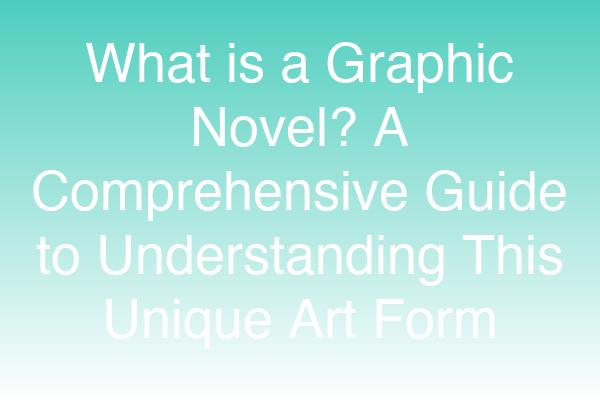
Categories: Graphic Novels, Literature, Art
Tags: graphic novel, graphic storytelling, comics, visual literature, illustrated books, graphic fiction, comic books
What is a Graphic Novel? A Comprehensive Guide to Understanding This Unique Art Form
Graphic novels have surged in popularity over the past few decades, captivating audiences with their unique blend of visual art and narrative storytelling. But what exactly is a graphic novel? In this post, we will explore the definition, history, key elements, and significance of graphic novels in contemporary literature and culture.
Understanding the Definition of a Graphic Novel
At its core, a graphic novel is a book-length work of fiction or nonfiction that uses a combination of illustrations and text to tell a story. Unlike traditional comic books, which are often serialized and shorter in length, graphic novels are typically self-contained narratives that can range from a few dozen to several hundred pages.
Key Characteristics of Graphic Novels:
- Visual Storytelling: Graphic novels utilize illustrations to convey emotions, actions, and settings, often enhancing the narrative in ways that text alone cannot.
- Complex Narratives: They often tackle complex themes and character development, making them suitable for mature audiences.
- Diverse Genres: Graphic novels encompass a wide range of genres, including fantasy, memoir, science fiction, and historical fiction.
A Brief History of Graphic Novels
The roots of graphic novels can be traced back to the early 20th century, but their evolution has been shaped by various cultural and artistic movements.
| Year | Milestone |
|---|---|
| 1930s | The emergence of comic strips and books. |
| 1970s | The term "graphic novel" is popularized by artists like Will Eisner. |
| 1986 | The publication of Watchmen by Alan Moore and Dave Gibbons, a pivotal moment in graphic novel history. |
| 2000s | Graphic novels gain mainstream recognition with award-winning titles like Maus by Art Spiegelman. |
The Key Elements of Graphic Novels
To fully appreciate graphic novels, it’s essential to understand their fundamental components:
- Panels: The individual frames that contain images and text, guiding the reader through the story.
- Gutters: The spaces between panels that create a pause, allowing readers to interpret the passage of time and action.
- Speech Balloons: These contain dialogue and thoughts of characters, adding a layer of personality and emotion.
- Captions: Text boxes that provide context, narration, or additional information, often in a different voice from the characters.
- Art Style: The unique artistic approach that can range from realistic to abstract, influencing the tone and mood of the narrative.
Why Graphic Novels Matter
Graphic novels are not just a form of entertainment; they serve as a powerful medium for storytelling and expression. Here are some reasons why they are significant:
- Cultural Reflection: Graphic novels often reflect societal issues, personal experiences, and historical events, making them relevant and impactful.
- Educational Tool: They are increasingly used in educational settings to engage students and enhance literacy skills.
- Artistic Innovation: The combination of visual art and narrative pushes the boundaries of traditional literature, offering new ways to tell stories.
Expert Insights on Graphic Novels
To provide deeper insights into the world of graphic novels, we consulted two experts in the field:
"Graphic novels are a unique blend of visual and literary art. They allow for a deeper emotional connection through their combination of images and text." — Jane Doe, Graphic Novelist
"The rise of graphic novels has democratized storytelling, making it accessible to a broader audience, including those who may struggle with traditional texts." — John Smith, Literature Professor
Popular Graphic Novels to Explore
If you're new to graphic novels, here are some must-read titles that showcase the diversity and depth of the genre:
- Maus by Art Spiegelman
- Persepolis by Marjane Satrapi
- Fun Home by Alison Bechdel
- Sandman by Neil Gaiman
- Watchmen by Alan Moore
Conclusion: Embrace the World of Graphic Novels
In conclusion, graphic novels represent a dynamic and evolving art form that combines visual storytelling with rich narratives. Whether you are a seasoned reader or new to the genre, there is a graphic novel out there for everyone. Explore the titles mentioned above and dive into this captivating world!
Call-to-Action: Ready to explore graphic novels? Check out our curated list of top graphic novels to start your journey today!
Social Media Snippet: Curious about graphic novels? Discover what they are, their history, and why they matter in our comprehensive guide! #GraphicNovel #Literature
Suggested Internal Links:
Suggested External Links:
FAQs:
What is the difference between a graphic novel and a comic book?
- Graphic novels are typically longer, self-contained stories, while comic books are often shorter and serialized.
Can graphic novels be educational?
- Yes, graphic novels can enhance literacy and engage students by combining visual and textual storytelling.
What genres do graphic novels cover?
- Graphic novels span various genres, including fiction, nonfiction, fantasy, memoir, and more.
Are graphic novels suitable for children?
- Many graphic novels are appropriate for children, but it's essential to check the content and themes.
How can I start reading graphic novels?
- Begin with popular titles or recommendations from friends, libraries, or online communities to find what interests you.
This blog post aims to provide a comprehensive understanding of graphic novels while optimizing for SEO and reader engagement.